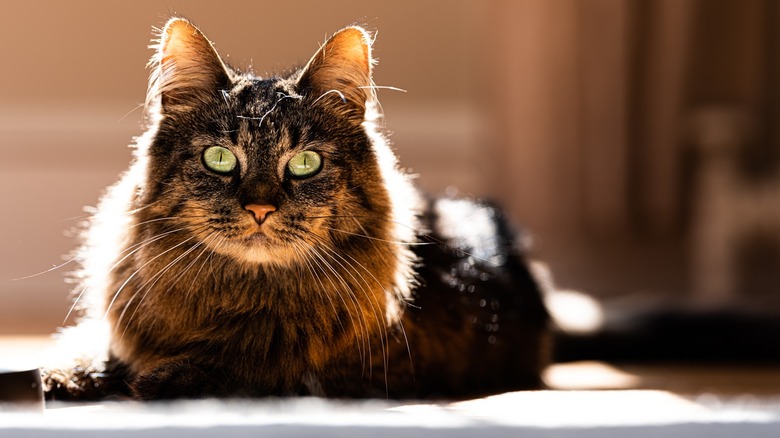These Are The Only Colors Cats Can Actually See
If you've assumed your cat can only see shades of white, black, and gray with their giant saucer eyes, you've thought wrong. It's become a common misconception that kitties are completely color blind. However, while your feline friend can't see the same scope of colors as you, they can pick up on some shades.
Though there is some debate about the topic, many researchers believe cats see three main colors: blue, gray, and yellow (green may also factor in). In contrast, they likely can't distinguish shades of red or orange. In fact, a cat's vision may be similar to that of a person who lives with red-green color blindness. The reason for this difference? It all comes down to the anatomy of their eyes.
Cat versus human color vision
Humans can see colors that kitties can't due to a difference in their photoreceptors called rods and cones. Cats have a lot of rods and not many cones. Humans on the other hand, have more cones and not as many rods. Cones control color detection, hence why humans can see a wider array of shades. Rods, on the other hand, dictate the level of dim light detection, and explain why felines are able to see so well in darker settings.
Some researchers have concluded that cats only have dichromatic color vision, or two types of cones. Humans, on the other hand, typically have trichromatic color vision. This limited number of cones is why cats can't pick up on more colors. However, this topic is far from cut and dry, and requires further exploration. "Although some studies point towards cats having all three types of color-detecting cone cells, they are unable to see the red-orange wavelength all that well," Dr. Rebecca MacMillan explained to PetsRadar. "This may be because there are fewer of the specific cones that are sensitive to red, compared to larger numbers of yellow and blue-detecting cones."
Other unique characteristics of cat vision
Cats have a wider field of vision of around 200 degrees due to their more wide-set eyes, whereas humans typically have one encompassing around 180 degrees. However, felines struggle to see long distances. While you might be able to clearly distinguish an object that's 100 feet away, your kitty won't be able to see it in detail until it's 20 feet away.
If you've ever noticed your cat's eyes glowing when they wake you up in the middle of the night, it's not just because their eyes are pretty; there's actually a scientific reason behind this. Felines have a tapetum made up of reflective cells that allows light to reflect through their retina, giving them this glowing effect, as well as allowing them to see in darker environments. Yet, while felines are known for having outstanding night vision, they actually aren't able to see in the pitch black, only in low-light.


